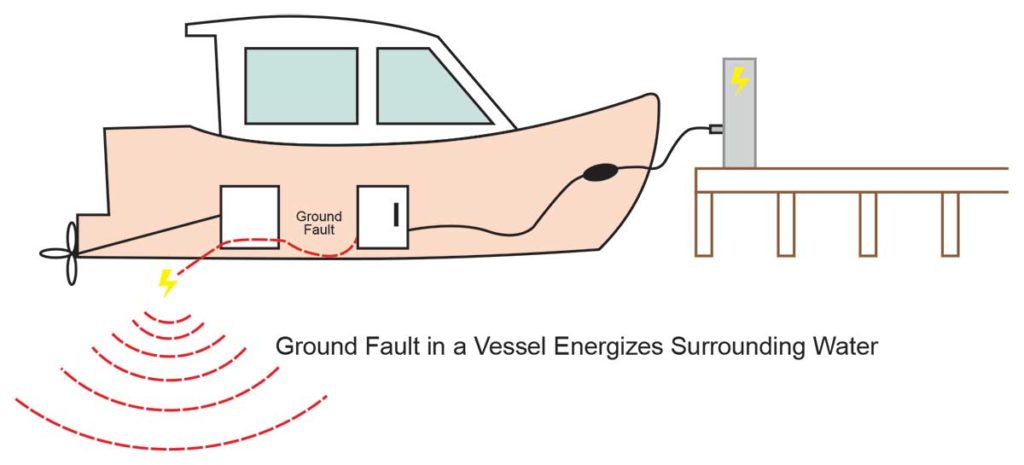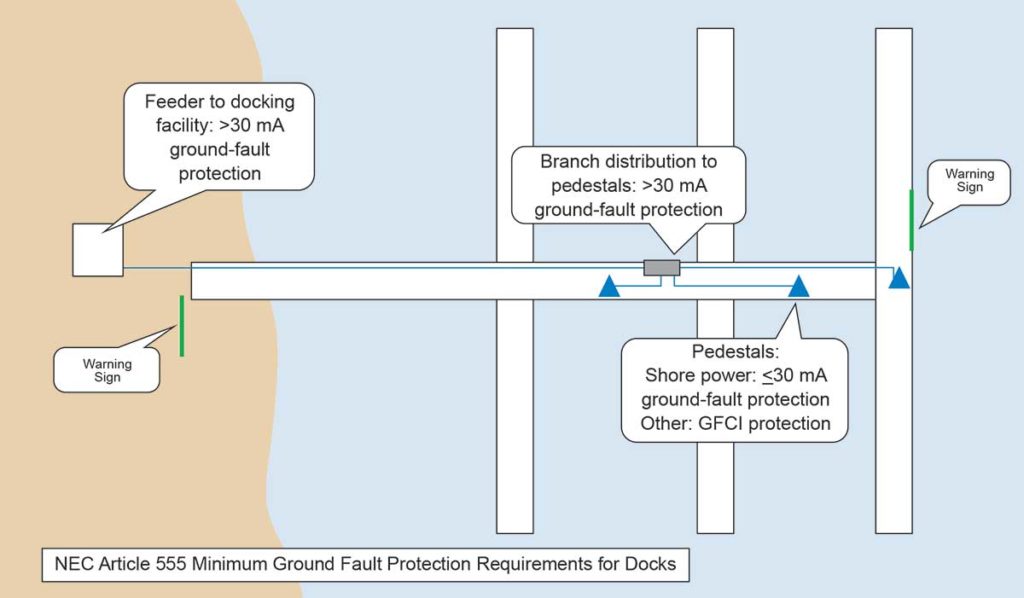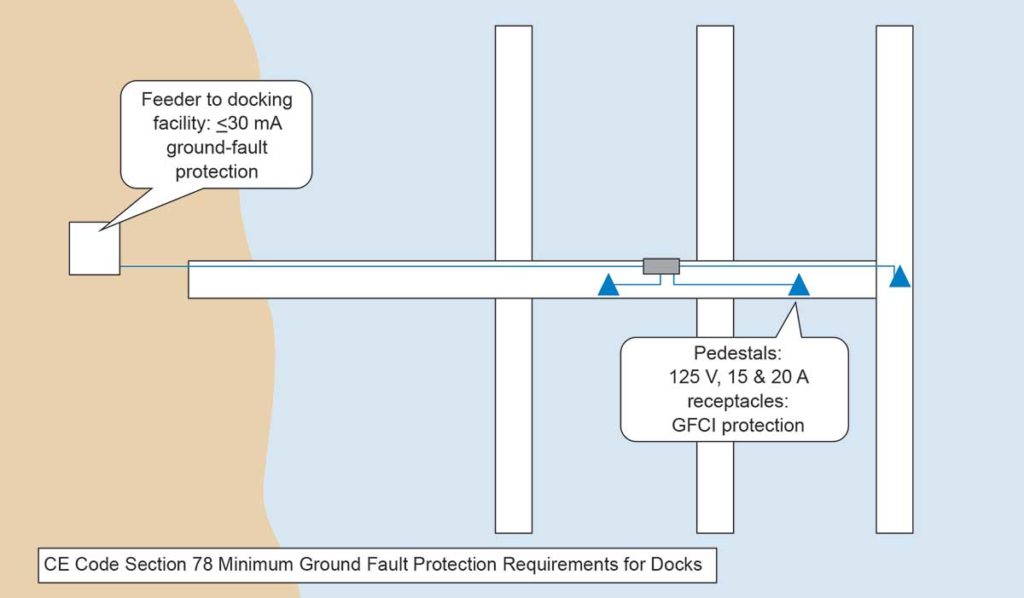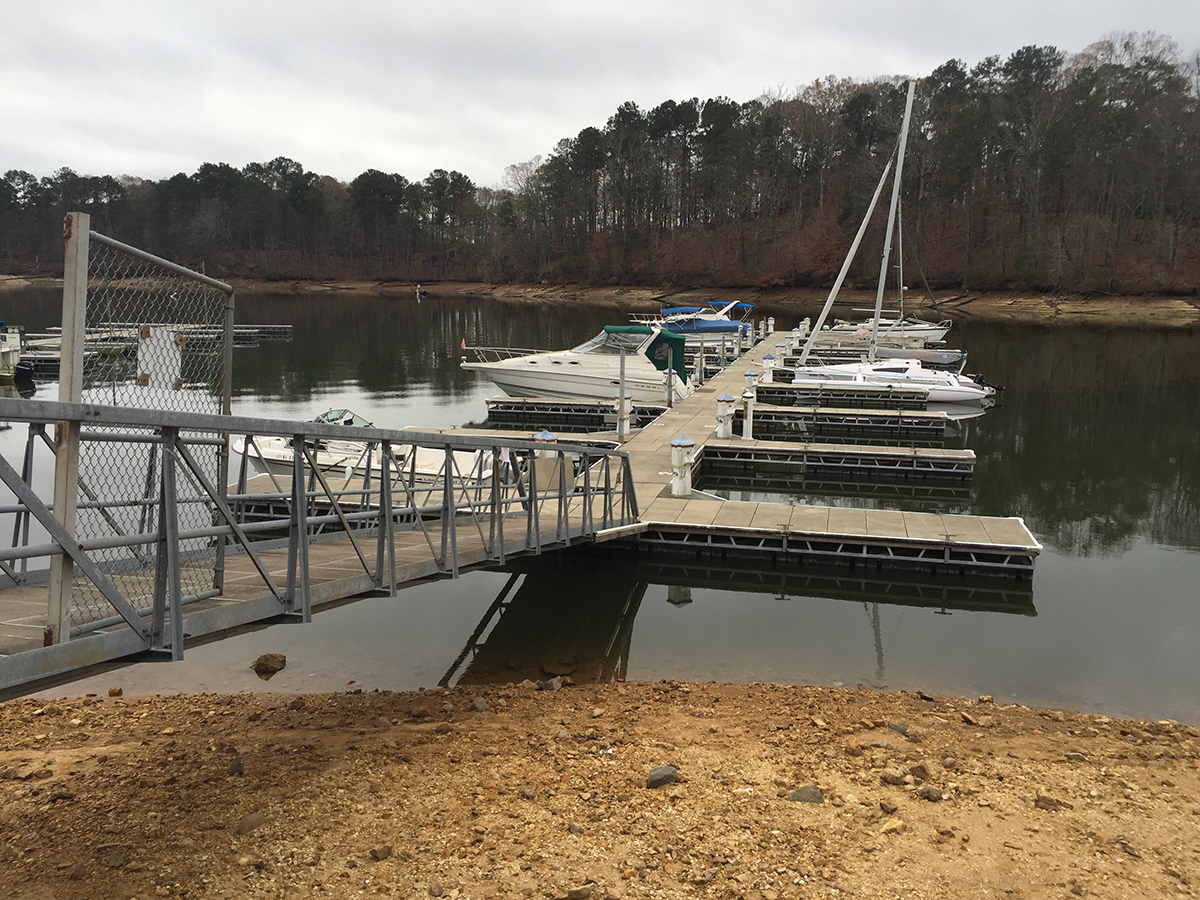Electric-shock drowning (ESD) tragically occurs when a child or adult enters a body of water that is electrically energized or when the water around a person suddenly becomes energized. If the electric shock is sufficient to prevent normal muscle control [as little as 10 milliamperes (mA)], it is impossible for the person to swim, and death by drowning can occur as a result. Sadly, there have been instances in which ill-fated rescuers have entered the water to save a swimmer in distress, only to succumb themselves.
Because the electric shock is usually not severe enough to cause obvious injury, the cause of many cases has not been recognized. However, these tragic events have occurred so often that The Electric Shock Drowning Prevention Association was created. Its website, electricshockdrowning.org, contains extensive material and resources related to the topic.
How does water become energized and how can the condition be recognized? An electric field within a body of water is completely invisible; without sensitive specialized safety equipment there is no way to determine whether a body of water is electrically safe. The typical sources of electrical energy in water are:
- Faulty wiring to or on a pier, dock, or marina, or
- In a boat connected to electrical power at a pier, dock, or marina.
An energized conductor of an electric circuit that is in contact with ground (the earth) through any path, directly or indirectly, creates a ground fault. A direct fault has the energized conductor in contact with ground, and an indirect fault has the damaged wire in contact with another conducting object, such as a boat drive system. In both cases, the result is a flow of electric current in a path outside of the intended electric circuit. If the fault-current path is through a poor electrical conductor, such as lake water or brackish water, the amount of current can be very low, not sufficient to cause a circuit breaker to trip or a fuse to open, but enough to disable a person. This condition can persist indefinitely, creating a lethal hazard.
The electrical-safety devices required by codes and standards to protect electric branch circuits from overcurrent conditions are rated to trip when current has reached 15 A (fifteen thousand mA) or higher, more than 1,000 times higher than the amount of current that can cause electric-shock drowning. Clearly, there is a gap between overcurrent protection and ESD protection.
The United States National Electrical Code® (NEC®) and the Canadian Electrical Code® (CE Code®) require sensitive low-level ground-fault protection to reduce the incidence of ESD. The NEC 2017 and CE Code 2018 were updated to further enhance these protections. The codes are adopted by various regulatory authorities (states and provinces) and enacted into law by their legislatures, either amended or verbatim. The states and provinces delegate the responsibility to ensure installations comply with regulations to local authorities having jurisdiction (AHJs), often referred to as electrical inspectors.
NEC Articles 553, Floating Buildings, 555, Marinas, Boatyards, and Commercial and Noncommercial Docking Facilities, and 682, Natural and Artificially Made Bodies of Water, each have requirements relevant to the prevention of ESD. (Chapters 1 through 4 of the Code also apply to these installations.) The ground-fault protection provisions of 555 and 682 have been extensively modified by Tentative Interim Amendments (TIA); TIA 17-15, and 17-16 (TIA Log #1348 & #1349), respectively.
CE Code Section 78, Marine wharves, docking facilities, fixed and floating piers, and boathouses, defines ground-fault protection required for those types of installations, supplementing the general requirements of the code.
NEC-2017
NEC 553, Floating Buildings
Floating buildings, as defined by NEC Article 553, are required to have ground-fault protection not exceeding 100 mA, either at the main overcurrent protective device feeding the floating building or at each branch or feeder circuit on the structure. “Protection” requires tripping the main circuit breaker or the specific faulted circuit when ground-fault current of 100 mA or more is detected.
The ground-fault protection requirements of Article 553 did not change between 2014 and 2017 editions.

NEC 555, Marinas, Boatyards, and Commercial and Noncommercial Docking Facilities
Previously excluded, the 2017 Scope of Article 555 was expanded to include one-family, two-family, and multifamily dwellings, recognizing that electric shock drowning is equally a hazard on residential properties.
TIA 17-15 added Docking Facility and Marina definitions to Article 555.2 and amended ground-fault protection requirements in 555.3 as compared to both the NEC 2017 and 2014 Articles. Docking-facility receptacles that provide shore power to vessels are permitted to have ground-fault protection set to trip at ground-fault currents not exceeding 30 mA, in lieu of the 210.8 requirements for ground-fault circuit-interrupter protection for personnel (see figure 2).

In addition, TIA 17-15 requires ground-fault protection for feeder and branch circuits on docking facilities, set to trip for currents exceeding 30 mA; feeder-level protection is permitted to be coordinated with downstream ground-fault protection. Coordination can be with both time settings (trip times are not discussed in the Code or TIA) and current settings. While not necessarily the intent of the TIA authors, a literal interpretation of “currents exceeding 30 mA” permits protection settings higher than 30 mA for coordination purposes. Values up to 100 mA have been recommended.1
NEC-2017 555.19(A) mandates that each shore-power receptacle must be supplied by an individual branch circuit. This, in turn, requires ground-fault protection for currents exceeding 30 mA at the branch circuit supplying each shore-power receptacle as per the above-mentioned TIA 17-15 amendment of 555.3. NEC 555.19(A) also mandates that each shore-power receptacle must be rated not less than 30 ampere.
NEC 555.19(B) mandates the use of GFCI personnel protection for 15- and 20-ampere, 125-volt receptacles in several specific locations supplemental to the requirements of Article 210.8 and requires that they be marked to exclude their use as shore-power receptacles if located in an enclosure also housing shore-power receptacles.
In contrast to the NEC 2017 and TIA 17-15 Article 555, ground-fault protection requirements, the NEC 2014 edition only required that a marina’s main overcurrent device have ground-fault protection set to no more than 100 mA, plus 125-volt GFCI protection in certain areas where those receptacles were to be used for specific appliances (portable hand tools, diagnostic equipment, portable lighting).
In addition to the enhanced ground-fault protection of the 2017 edition, the NEC also requires permanent signage warning about the danger of electrically energized water near a boat dock or marina. The signs must state, “WARNING—POTENTIAL SHOCK HAZARD—ELECTRICAL CURRENTS MAY BE PRESENT IN THE WATER” and the sign must be visible from all approaches to a marina or boatyard, per Section 555.24.
NEC 682, Natural and Artificially Made Bodies of Water
When TIA 17-15 defined Docking Facility as a structure to which boats are secured, piers that do not accommodate boats were excluded. The potential hazards toward electric shock drowning in the vicinity of electrified piers were addressed with TIA 17-16 which amends Article 682 by adding a definition of “pier” and updating ground-fault protection requirements.
While TIA 17-16 does not change GFCI requirements for 125- through 250-V receptacles, it establishes new requirements for feeder and branch circuit ground-fault protection. Except for the lack of shore-power rules, TIA 17-16 aligns with TIA 17-15 by requiring branch and feeder circuits that are installed on piers to have ground-fault protection for currents exceeding 30 mA, and that protection can be coordinated with downstream ground-fault protection.
In contrast to the Article 682 GFCI protection requirements of NEC 2017 and TIA 17-16, NEC 2014 only required 125- to 250-V GFCI protection in certain areas if those receptacles were to be used for specific appliances (portable hand tools, diagnostic equipment, portable lighting).

2018 CE Code
Section 78 Marine wharves, docking facilities, fixed and floating piers, and boathouses
CE Code Section 78 was extensively re-written for the 2018 edition. This includes new definitions for boathouse, docking facility, fixed and floating piers, and marine wharf. Ground-fault protection rules include Class A GFCI protection for 125-volt, 15- and 20-ampere receptacles located outdoors on piers, docking facilities, wharves, and boathouses. Each shore-power receptacle must be supplied by its own branch circuit. For circuits not required to be GFCI protected, each feeder for distribution equipment in or on a pier, docking facility, or boathouse must have ground-fault protection at a level not greater than 30 mA. Feeder voltage is not mentioned (see figure 3).

The previous CE Code 2015 did not have a requirement for ground-fault protection of feeders for distribution equipment.
Enhancing Safety
It is clearly ill-advised, and potentially fatal, to swim or even wade in water that is close to an electrical source. The automated protection of even the best-designed electrical system should not be a substitute for safe behaviors—we don’t bathe with plug-in electrical gadgets just because they are plugged into GFCI-protected receptacles.
Low-level ground-fault protection for circuits over 250 V is sometimes provided as an integrated function in circuit breakers. This provides simplicity, but there are technical and commercial limits. The circuit breakers which are available typically have no adjustments for ground-fault pickup level (usually 30 mA) or trip time (usually instantaneous)—they cannot be used in a selective fashion. Ground-fault circuit breaker availability is limited to a small number of voltage and current ratings.

In lieu of integrated ground-fault-overcurrent devices, installations can use circuit breakers with a shunt-trip input that can accept a trip signal from a dedicated ground-fault detector. A well-designed ground-fault device can be adjusted for both trip-level and time-delay values to provide the selective tripping that ensures only the faulted circuit is de-energized while keeping the remaining facility in safe operation. Some ground-fault relays include a display that indicates measured leakage current and can even have the ability to monitor multiple circuits simultaneously and to quickly trip only the affected section via the correct feeder or branch shunt-trip circuit breaker.
Marina designers, constructors, and owners can choose their correct mix of ground-fault circuit-breakers, custom integration of ground-fault relays and shunt-trip circuit breakers, or off-the-shelf ground-fault panels and shunt-trip circuit breakers (see figure 4). Marina owners should consider the increased safety afforded by the new minimum national standards required for new construction by the relevant Code, even for existing facilities. The updated NEC-2020 addresses some of the issues mentioned in the 2017 TIAs. Additional changes for the NEC-2020 can be found in the article, “NEC 2020 Updates Impacting Electric Shock Hazards.” Electric shock drowning risks can be minimized by utilizing the latest safety equipment.
NEC 2020 Updates Impacting Electric Shock Hazards (link)
References
- Technical Bulletin: More Electrical Changes in Marina Code. Marina Dock Age. Published 26 June, 2018; accessed online at https://www.marinadockage.com/technical-bulletin-electrical-changes-marina-code/.











Find Us on Socials